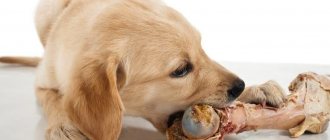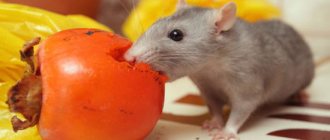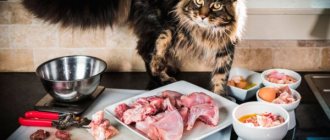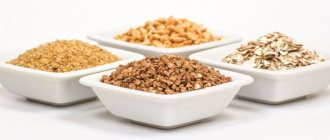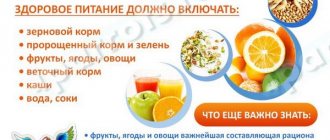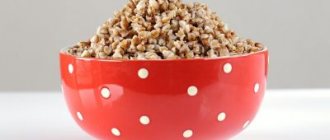Dog bones are a topic that generates a lot of controversy. Some dog lovers claim that animals do not need moss because they do not contain valuable substances. But they can pierce the stomach or intestines, causing the death of the pet. Others say that bones, especially cartilage, are useful for animals, but in their raw form, and not all of them. When asked whether it is possible to feed a dog bones, both sides answer this way: you cannot give the animal bones alone. Such a “diet” will cause illness and death of the dog.
Why do dogs chew bones?
The habit of a pet to chew bones is a long-standing instinct, fixed by evolution. The ancestors of dogs were carnivores; they obtained all the necessary substances from meat, including fat. At the same time, many predators lived in conditions unfavorable for survival.
Cold and heat had a bad effect on the growth of plants that artiodactyls ate. And they died. Accordingly, this affected the diet of predators. When they couldn't reach the prey, bones remained - the last reservoir of fat for a dog that had fallen on hard times.
Bone marrow, which is found inside the bones, contains:
- fat (more than half of the composition);
- vitamins B1, B12, B2, E, A;
- protein;
- iron;
- phosphorus.
Thus, when prey is in poor condition, eating it along with moss increases the value of the meat. This theory is confirmed by the remains of extinct dogs, the structure of their teeth and powerful jaw muscles helped them crush bones.
Modern pets who receive adequate nutrition do not have the need to search for food using this method, but the habit remains. Their jaws are not as strong as those of their ancestors, but even a small dog will sooner or later destroy the largest bone.
Motivation has also changed. When a pet chews on moss, it increases the synthesis of endorphins, which are responsible for pleasure.
Other reasons why a dog chews bones
- Boredom. This problem is especially common among owners of young pets, whose energy is in full swing, but there is no exercise.
- Teething, other dental problems. Bones help your dog cope with pain.
- Fear of separation - often occurs when the dog is left at home alone. This way it calms the nerves.
Historical roots and genetics
Ancient canids
Dogs are predatory animals that began hunting in packs 8 million years ago. Hunting in organized groups, they received large, abundant prey, and under these conditions their jaw apparatus actively developed. The teeth became larger and the jaws became more powerful.
Like any other instrument, the dental apparatus requires care, and it also requires training to enhance its qualities. Just as cats scratch objects to sharpen their claws, dogs chew bones, and sometimes sticks, tree rhizomes to clean and sharpen their teeth, give their jaws the necessary load, and train them. After all, at home they eat mainly soft, cooked food, and they do not have enough such stress. Chewing bones, and in their absence, other objects, is a purely instinctive action.
Are bones beneficial or harmful?
Raw moss contains minerals, vitamins and other nutrients that are beneficial for dogs. The cartilage, which is located at the edges, strengthens the dog’s joints, makes them stronger, and prevents arthrosis. Chewing stimulates the production of saliva, which helps prevent plaque on teeth and gum disease. In addition, a dog that chews a bone is less likely to chew and lick its paws and tail.
At the same time, the cooked product is not healthy at all. Under the influence of high temperature, vitamins and minerals disintegrate, and bone marrow also loses nutritional value. The callus becomes too fragile, sharp pieces easily break off, which can pierce the dog’s insides and block the passage. Intestinal obstruction is one of the main causes of death in homeless animals.
Why shouldn't dogs be given bones?
When a dog chews a callus, it leaves behind sharp edges that can:
- damage tooth enamel;
- cause broken or worn down teeth;
- get stuck in the gums, between the crowns;
- injure the gums, tongue, and mucous membrane of the digestive tract;
- pierce the stomach or intestines, causing internal bleeding that is life-threatening;
- induce vomiting if the stomach becomes clogged and does not pass further;
- cause constipation, inflammation of the anal glands.
Regular use is deadly
Many are convinced that the domestic dog is a predator, and that bones are an integral part of his daily diet. We must immediately warn you that bones for dogs do more harm than good. They are too rough a product and overload the chewing muscles and jaws. The consequence of this may be a change in the bite. If they are consumed frequently, tooth enamel is inevitably damaged and there is a risk of caries and pulpitis. Poorly chewed, they can get stuck in the throat and injure it. A meat feast can end with asphyxia or life-threatening bleeding.
Particular attention should be paid to the fact that it is strictly forbidden to give boiled or other heat-treated bones.
Such food is extremely fatty and high in calories. It is very difficult for the body to digest and assimilate it. Under the influence of gastric juice, this food turns into a compacted sticky lump, which is like a dense cork. The most terrible delicacy is jellied meat. The semi-digested mass fills the intestines. Symptoms of colon blockage include constipation, diarrhea, sometimes accompanied by blood, and severe vomiting. With regular poor nutrition, the animal's metabolism is disrupted. The consequence of this is decreased gastric acidity. For this reason, solid fragments are not completely digested, but clog the stomach, forming a kind of sharp lump. If this poorly digested bone enters the small intestine, perforation will occur. The consequences of this can be fatal - peritonitis or necrosis. In case of such serious complications, only surgery is indicated. The conclusion is that frequently giving a dog bones is a crime against its long, healthy life.
What bones to give your dog
Is it possible to give your pet raw bones? Yes, in small quantities, without fat! It is advisable that the mosli be made with meat. These can be spongy, soft, non-sharp foods, as well as bones that are difficult to chew or swallow.
What bones are best to give to dogs:
- large beef haunches, tail, shoulder blades;
- uncut joints;
- cartilage;
- bird neck;
- bird wings without the first joint;
- bird feet without claws;
- bird heads with a torn off beak;
- chicken backs;
- veal knees.
Before giving your dog beef bones, make sure they are smooth. Porous muscles with holes break more easily and cut the mouth faster. To check if the product will crack, scratch it with your fingernails. If marks appear, it will easily break, leaving a sharp fragment, and therefore dangerous for the pet.
What bones should not be given to dogs?
Can a dog chew boiled bones? Veterinarians do not recommend it. Boiled bones do not contain useful substances, and the pet can clog the stomach, causing constipation. They crumble easily, break off, and a sharp piece can injure the dog’s insides.
Completely prohibited:
- Tubular ones, chicken ones are especially dangerous. They form many sharp fragments that can injure the dog. If you really want to give your dog a chicken leg, give it not a bare raw bone, but with meat. The pet will chew it and turn it into a meat cutlet. In this form, the product will not cause harm and will be absorbed without problems.
- Fish bones. They are sharp, thin, easily penetrate the mucous membrane, after which they are difficult to remove. Under unfavorable circumstances, they can cause suffocation.
- Formations that a dog can easily swallow. They can cause blockages.
- The head, even with meat. When eaten, many small bones are formed, which clog the stomach and are unable to move further. As a result, the dog burps.
- The middle part of the ribs. There are useful cartilages along the edges, but the middle part is dangerous - it crumbles easily, breaking into small fragments.
What you can pamper
Beef callus, a large femur with the remains of meat, as well as ribs at the cartilage stage are practically the only type of bones that are given to a pet. After he gnaws all the meat and cartilage tissue, even such harmless beef bones must still be taken away.
Lamb is considered environmentally friendly and nutritious. Almost does not cause allergic reactions, because it is a rare source of protein in the diet of pets, unlike beef or chicken. Sometimes you can give lamb bones to chew on. But only soft boiled cartilage or very large fragments that cannot be eaten quickly are suitable for this. You definitely need to have time to pick them up before they are chewed into small pieces. An unusual delicacy is cartilaginous veal ribs. You can cook porridge using various parts of bones. After the dish is completely ready, they must be removed.
Although certain types of bones are relatively safe to eat, they should only be offered to your pet as a toy or temporary entertainment.
At what age can a dog be given bones?
Very small puppies do not need bones. Their digestive system is just being formed, and solid formations can damage internal organs and cause constipation, vomiting, and suffocation.
Some owners give bones when baby teeth grow (3-8 weeks) and the puppies chew on everything. This cannot be done. Baby teeth are very fragile and can break, which will negatively affect the shape of the jaw. Give toys instead of bones.
Soft, raw moss can be given when puppies begin to change their teeth, between 12 and 24 weeks of age. The puppy may have pain in his gums, in order to drown out the pain, he may start chewing everything. It is worth noting that some veterinarians do not recommend bones for puppies during this period. They advise waiting until the teeth are completely replaced by real teeth.
When your pet chews on the moss, pay attention to the dog's reaction. If constipation occurs, the animal arches its back and groans - this means that they do not move well through the intestines, bones cannot be chewed. Over time, when the body becomes stronger, the problem may disappear.
If the puppy threw a bone and it dried out, the product should be thrown away. In this state, it becomes brittle, breaks easily and can break into dangerous parts.
Veterinarian advice
You can safely treat bones to pets who eat natural meat. Especially if you often give raw meat. Gastric juice successfully digests them.
If the dog is fed industrial food, bones are prohibited. Her digestive tract is accustomed to a different type of food and does not digest bone tissue well. The result is vomiting, constipation, and less often diarrhea.
Dogs that have problems with the gastrointestinal tract do not need mosley. Especially if they are taking medications that reduce the stomach's ability to secrete juice.
Pregnancy and lactation
Bones are not recommended for pregnant bitches one week before giving birth. Their body increases the level of calcium that puppies need for development, so there is a risk of hypocalcemia. In addition, mosli overloads the stomach, and during this period it is especially difficult for it.
Bones are not recommended for a bitch at the beginning of feeding puppies. When babies see their mother, they reach for the udder and begin to suck milk. If she has eaten at this time, vomiting is possible. The gnawed fragments can fall to the floor and end up in the puppies' mouths, which can lead to disastrous results.
Arguments for
- Gnawing on the right bones is good for the dental system. Pets that are limited in solid food do not have the necessary exercise. This leads to gum disease and loosening of teeth, because there is no training and massage of the gums. In addition, soft plaque is naturally removed and tartar does not form.
- Bones, although not a replacement for good nutrition, are an additional source of minerals: calcium, phosphorus, boron. If a dog chews cartilage, it is also good for joints, it contains glucosamine and chondroitin.
- In addition, bones are a natural “distraction” for the dog and anti-stress. After all, pets can usually chew a tasty bone with gusto, so much so that they cannot be seen or heard.
Useful tips: reminder
- Bones are useful only raw, preferably with meat.
- Give mosly only after food, when the dog has eaten.
- Don't leave your pet alone to chew on a bone. She can choke on them and injure herself.
- A dog should not eat bones on an empty stomach before active walks.
- Do not allow your dog to chew moss for more than 15 minutes. in a day. This will reduce the risk of injury.
- The dog should not gnaw on prohibited bones, the destruction of which will result in splinters.
- Can you give dogs tubular bones? Any veterinarian will give a negative answer.
- Do not allow your dog to chew the callus into small pieces.
- Do not give your pet a product that she may ingest to avoid gastrointestinal blockage.
- When not in use, keep the mosli in the refrigerator. It should be thrown away after 3-4 days to reduce the risk of bacterial infection.
- Get rid of the bone if your pet has gnawed it completely.
- Take the bone away from your dog if he can bite it and swallow it. Owners of pit bulls and other breeds with powerful jaws should be especially careful.
- If the dog tends to swallow large pieces, mosly is not recommended.
- Take away all sharp fragments and large pieces that were formed as a result of chewing.
- If you think the bone is dangerous, don't give it.
Safe Alternative
In specialized stores you can purchase carefully processed or artificial analogues of natural cartilage and muscles.
Artificial bones for dogs – how to choose
An industrially produced treat is optimal for a dog that eats dry food. Similar cartilages are sold in all pet stores and are inexpensive. Manufacturers produce different types of artificial analogues that do not harm the health of the pet. The following bones are available for sale:
- Calcium, beneficial for tooth enamel and musculoskeletal health.
- Made from dry veins, intended for cleansing and massaging the oral cavity. This type does not cause a food reaction, so it is well suited for dogs with allergies.
- Chewable, which is given to four-legged animals only from 4 months of age.
- Gelatin, which is an additional source of collagen. These analogues are useful for pregnant and weakened individuals, as they are enriched with vitamins and minerals.
When choosing artificial cartilage, it is important to find an option suitable for your four-legged pet. Its size must correspond to the dimensions of the individual. A small cartilage can cause suffocation in a giant pet, and an artificial one that is too large can cause injuries to the jaws and teeth of small breeds.
Minced bone
Mechanically processed solid residues are obtained as a result of the production of sausage products and semi-finished meat products. It is a cheap product that owners use to feed their animals.
Dog bone mince is useless because it does not contain any beneficial substances. The particles do not enrich the four-legged body with vitamins and microelements. There are cases when pieces of minced meat accumulate in the intestines and cause constipation, which is dangerous for the pet.
Special toys
Sometimes cartilage and muscles replace toys for dogs. But pet stores sell special items that your four-legged friend can chew for health benefits. These are toys made of safe plastic or rubber in the form of bones or bird carcasses. Such items can distract your pet during periods of loneliness and clean plaque from the surface of the teeth.
Question answer
Are bones good for dogs?
Mosli contains nutrients, but these days they can be compensated for with proper nutrition, vitamins, and treats.
What mosli should I give my pet, boiled or raw?
Only raw.
Is it possible to give a dog fish with bones?
It is possible, but only with a soft backbone (eg sprat).
Can a dog eat beef moss?
Yes. First make sure that they are fresh, there are no chips and the dog will not swallow one at a time.
Can a dog have a turkey bone?
It depends on what part. You can give wings and a neck. Tubular no.
Can a dog have lamb bones?
Large spongy ones are ok, small ones are not (they may separate).
Can my pet have chicken bones?
Tubular bones cannot be given to a dog, while neck, wings, and back can be given.
Can a dog have pork chops?
The answer is yes, but first you need to cut off the fat from them.
How often should I give bones to my pet?
You can do it every day, but not much.


